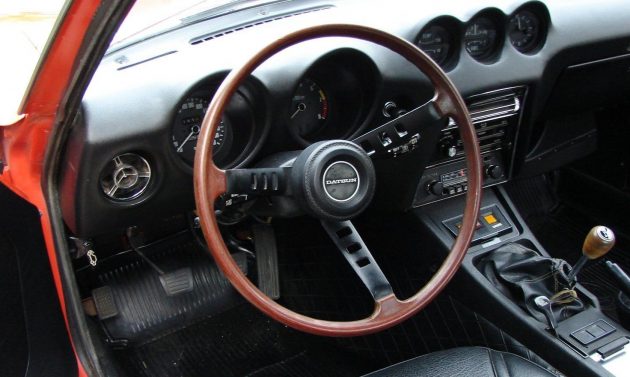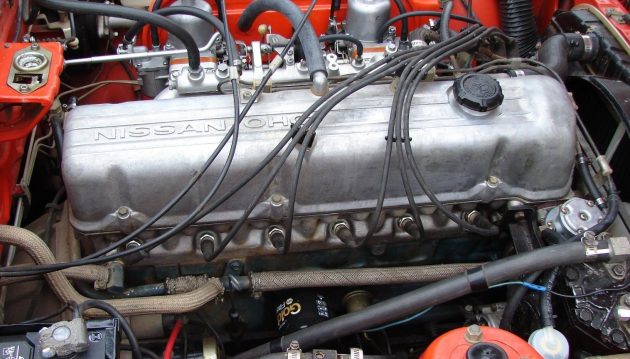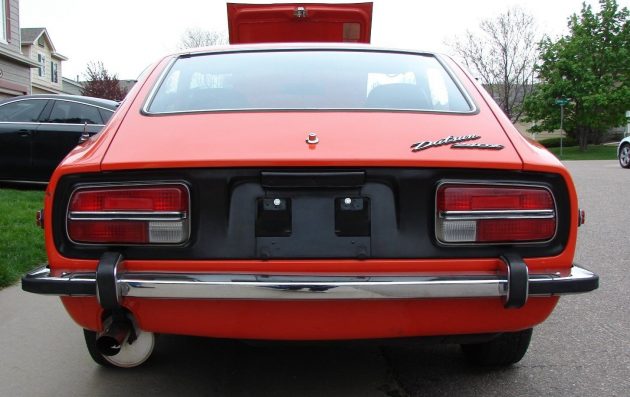I really don’t dig re-painted cars. Here and there, fine. All of my cars have had a panel or two (or three…or four) repainted, but when it comes to survivor vehicles, I like for there to still be some original colors attached. In the case of this 1973 Datsun 240Z here on eBay, I’m going to make an exception: the paint job is 20 years old and the rest of the car is excellently preserved.
An added bonus is that it’s a manual transmission. I feel like the vintage Z car is one of those vehicles that often times presents itself as an incredible survivor, only to find out it’s due to an automatic gearbox allowing it to lead a life of luxury. This car has just over 62,000 original miles and remains in nearly factory-correct condition, down to the stock radio that’ll still pick up your local Top 40 station. The interior, if you can believe it, is original and a testament to the previous owner that lovingly cared for it. Even the A/C still blows cold!
Even though it’s a repaint, the previous owner did it the right way: the same color, and left the door jambs and engine bay alone, so it still wears original paint in those places. The engine is said to run well and benefits from a rebuilt and upgraded carb. Now, I had to do some research here because the seller swapped in a carb setup from the 1972 model year. Turns out those earlier intakes were water-warmed, helping to atomize the fuel faster when the engine is cold. If any of our Datsun experts are reading, I’d appreciate clarification on this. Thanks to ZTherapy.com for the info.
There’s one beauty mark to the left of the driver’s side taillight that is attributed to long-term storage. That can happen. I have a nice ding on the trunk lid of my ’87 325is, due to trying to squeeze a Recaro seat past it to store it in the back of my rental garage unit. Of course, I should have just backed the car out, but that seemed like an inconvenience. My ballyhooing aside, this is quite the survivor if the originality claims hold water, and I like it even with the repaint. Bidders seem to agree, as the auction is up to over $15,000 with lots of time left.






Ironic earlier today I was on Craigslist looking for a Blue Datsun 240z with white interior. In 1970 I walked outside our apartment complex in Santa Cruz and saw for the first time a Datsun 240z and fell in love with it. The owner had to tell me three times , “that yes it’s a Datsun” His was Blue with the white interior with the aftermarket polished ” Mag ” wheels. After all of these years it’s still near the top of my list.
The stock carbs on ’73 Z cars like this one were the dreaded flat top carbs. They robbed performance and were used only because they allowed the cars to meet the stricter ’73 emissions limits. I would guess that thousands of ’73 Z cars have had the flat tops replaced by the earlier round top Hitachi carbs from earlier cars that were parted out.
The hot water heating of earlier round top carbs was used to better atomize and burn the fuel to reduce emissions. But the most sought after carbs are the earliest, from ’70 or ’71, and I have seen sets offered in excellent or new/rebuilt condition for more than $1K. If you need your round top carbs fixed or rebuilt ZTherapy is the place to go if you can’t do it yourself.
This car has had the emissions-control doo-dads removed from the intake manifold to simplify things, but with all that stuff gone (and usually trashed) it becomes a problem for people who want to do an accurate and complete restoration to source all of that stuff if their engine doesn’t have it.
This car looks good, but I would be a bit concerned about the compression. 125 PSI is low for these cars, and the ’70 240Z engine that I am rebuilding now had higher compression than that. I would want it to be in the 150-160 range for a good healthy engine.
The VIN given for this car isn’t right. It shouldn’t have the three 1s, and it should be in the range of about 130XXX or a bit lower to about 160XXX or a bit higher. But with the ’73 cars whatever the VIN really is doesn’t matter since the ’73 240s are the ones with the lowest values. But this is such a nice car that I think a good price is deserved, especially with the round top carbs. $20K isn’t out of line.
Dolphin, were the Hitachi carbs an SU knock off? They look like SUs in the limited view of the engine.
Stephen,
Most sources say that Hitachi made these carbs under a license from SU. Since the SU and Hitachi carbs on the ’70-’72 240Z are essentially identical, and the 240Z was sold in the UK where SU carbs originated, I think the licensing story is correct.
Compression would be a bit higher on the ’70 (by design) as it’s a different head (combustion chamber shape). Also the test may be inaccurate. Was engine warm? Was throttle open?… probably nothing wrong at all.
Growing up with these,I still don’t care for the ’73’s,
as the bumper overriders just don’t “look right” to me.
“73’s also had problems with emission equiptment.
I remember that they wrapped the fuel lines in asbestos
at the dealer trying to correct the problem.
The reason Hitachi carbs were replaced (I know I have one and did it) is the fuel boiled in them that is why the heat shields was there. Once replaced with the 71 carb and intake not a single issue??
One reason why fuel boiled in your flat top carbs is that coolant was piped through them to help atomize the gasoline so it would burn more completely, which reduced emissions. That made them run very hot. See:
http://www.zparts.com/zptech/tech_tips/izccposts/su_differences.htm
All 240Zs came with Hitachi carbs. You didn’t say, but I assume your car was a 1973 240Z. The 1973 cars got flat top Hitachi carbs instead of round top Hitachi carbs because 1973 was a year when the amount of car emissions allowed was significantly reduced in the US, and a lot of car manufacturers had to make changes to engine systems that allowed the emissions standards to be met so they could sell cars.
Most people who owned 1973 M.Y. cars of various makes back then will tell you that those cars ran worse than previous versions—and they got worse gas mileage also.
The flat top Hitachi carbs were more complex inside, and that made them harder to set up properly and harder to keep them working properly. All of that tended to make cars that had them run poorer than cars with the round top carbs.
All 240Zs had heat shields. I have owned two early 1970 240Zs, including one built in January 1970, and they both had heat shields between the exhaust manifold and the carbs. I assume that Datsun put heat shields on their cars because it is better for performance to have the air intake system as cool as possible for a denser charge because that produces more power.
So, a reason why the 1973 240Zs didn’t perform as well as cars from previous years is that the intake system was always very hot from the hot coolant, which reduced the density of the charge. And one reason why replacing the hot-water-heated flat top carbs on a ’73 240Z with non-hot-water-heated round top carbs is that the intake system would not be heated by hot coolant, allowing for a cooler, denser charge.